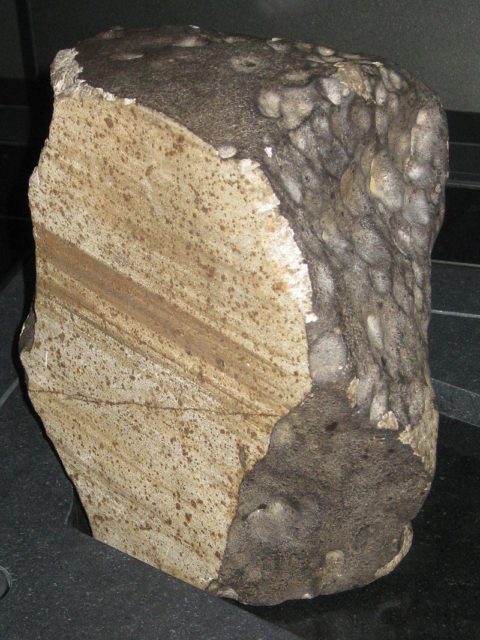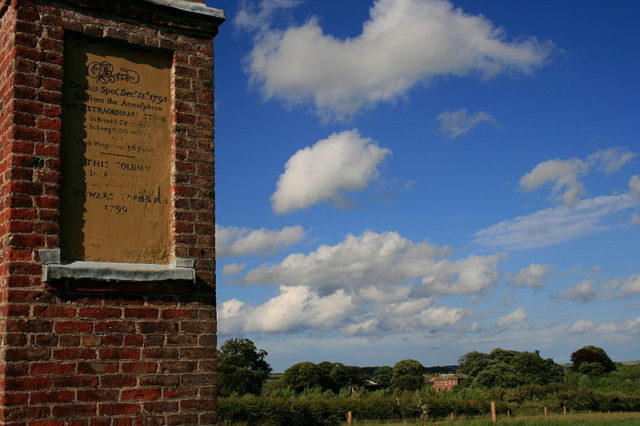Imagine an 18th-century man working on a farm when a black stone from a thunderous sky approaches at high velocity and falls only 150 yards away. This is what happened to a farmhand in the small village of Wold Newton, East Yorkshire. The farmhand was no doubt shocked and confused–and totally unaware that he was a firsthand witness to the biggest meteorite to fall in Britain’s recorded history.
The event described here happened on the 13th of December, 1795. It was 3:00 PM in Wold Newton, and a thunderstorm raged across the sky. John Shipley, who was a farmhand on the property of Newton’s magistrate, Major Edward Topham, was plowing the field when suddenly he heard an explosion that was unlike the sound of thunder and he saw a “dark body” descending from the sky. In a few seconds, this dark body crashed to the ground. It fell so close to poor Shipley that he was covered by mud and the dust created by the impact–he was, of course, lucky that it wasn’t a bigger piece and it didn’t strike him. Shipley wasn’t the only witness to this event; written testimonies were later collected from several other people.
The meteorite that fell in Major Edward Topham’s yard created a crater that was about a yard across. The rock dug itself into the ground, managing to pass through 12 inches of topsoil and 7 inches of chalk rock. Witnesses did not hesitate to dig the rock out, when it was still warm from impact, and measured it–the rock weighed 56 pounds.
When Edward Topham saw the meteorite that fell on his yard, he immediately declared himself “charmed.” Intrigued, he wanted to know more about its origin. The local newspapers also heard of it, and the meteorite became a sensation.

It was pure luck that this charming piece of space debris fell into his hands. Besides being a landowner and magistrate, Major Edward Topham was a playwright and the owner of a daily newspaper in London called The World. Topham was a man who respected scientific truth and, thanks to his efforts, scientists got the chance to study it. He meticulously gathered witness accounts and concluded that the object that fell was a genuine rock from space. He wanted to solve this mystery for his own sake and the sake of all the confused people in his village. After all, heated stones don’t fall from the sky every day, especially not in a place where volcanoes don’t exist. People were probably scared and connected this event with some godly intervention. Topham later arranged for further scientific study, and he exhibited it publicly in London.
Besides being the most significant meteorite observed falling in Britain, the Wold Cottage Meteorite is the second-largest meteorite that was seen to fall in Europe (the Ensisheim meteorite is the largest). This rock from space played a major part in a critical 18th-century scientific debate. Scientists have questioned the existence of extraterrestrial matter for a long time before the Wold Cottage event. This meteorite served as evidence that proved the existence of space matter.

On the other hand, in the 1970s, the Wold Cottage Meteorite became a central subject in a series of science fiction books. The fictional text concerning the meteorite was so amusing and persuasive that people started to present it as part of the Wold Newton timeline mistakenly.
It was said that the passengers of a stagecoach that passed close to Wold Newton at the exact moment when the meteorite fell were somehow influenced by it. They entered a trance-like state of mind for the duration of the event, and when they woke up, they had no recollection of what really happened. According to the “legend,” all of the passengers and their future families became different, abnormal.

This tale, which some people thought was based on reality, is actually derived from the works of the American science fiction writer Philip José Farmer. In his two fictional biographies, Tarzan Alive (1972) and Doc Savage: His Apocalyptic Life (1973), Farmer used the factual story of the Wold Newton meteorite as a basis for the imagined story of his characters. He created what became known as the “Wold Newton Family.” In his invented biographies, Farmer speculates that the meteorite possessed some sort of radioactive element which caused the families of his characters (the people that were in the stagecoach that passed in the vicinity of the meteorite) to develop genetic mutations.
Their descendants inherited these mutations, which included amazing strength and extreme developed intelligence. Some of those descendants became superheroes, and some of them became villains. Farmer even made a family tree of all the characters from the Wold Newton family. The family tree includes a variety of already existing and popular fictional characters such as Tarzan, Doc Savage, and even Sherlock Holmes.
Later, Win Scott Eckert, another science fiction writer, created his own chronotope inspired by Farmer’s work and called it the “Wold Newton Universe.” It was an alternate universe in which various already existing fictional characters interact with one another.

Apparently, this is not the only weird event in this part of Yorkshire. It turns out that the region between Scarborough and Bridlington is famous for many strange events since ancient times. There have been stories about werewolves, screaming skulls, and zombies, and all of them come from places around Wold Newton and the Gypsey Race River. The ancient Britons used to call this river “Water of Woes” because every time its water levels elevated, a huge disaster would happen in the days to follow.
The Wold Cottage Meteorite and its history is a perfect mixture of science, legends, and fiction. It shows us that sometimes even a small piece of rock can help us discover or create a whole new universe.
For those who want to see this piece of scientific and fictional history, the Wold Cottage Meteorite is kept in the Natural History Museum in London.
